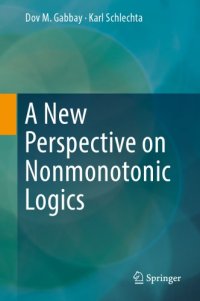
Ebook: A new perspective on nonmonotonic logics
Author: Gabbay D.M. Schlechta K.
- Genre: Mathematics // Logic
- Tags: Logic Symbolic and mathematical., Logic., Computer science., Philosophy and science., Artificial intelligence., Computer Science., Mathematical Logic and Formal Languages., Philosophy of Science., Mathematical Logic and Foundations., Artificial Intelligence (incl. Robotics), Default reasoning.
- Year: 2016
- Publisher: Springer
- Language: English
- pdf
"Logics are like shadows on a wall; to understand why they dance as they do, and how they can be made to move differently, one needs to look at the mathematical structures from which they can be projected. That is a methodology that has long proven its value for classical and other forms of deductive inference; this book manifests its pertinence to logics of uncertain qualitative reasoning. It draws together and Read more...
Abstract: "Logics are like shadows on a wall; to understand why they dance as they do, and how they can be made to move differently, one needs to look at the mathematical structures from which they can be projected. That is a methodology that has long proven its value for classical and other forms of deductive inference; this book manifests its pertinence to logics of uncertain qualitative reasoning. It draws together and refines work from the literature on preferential and other quite different semantics for such reasoning and then, in its central chapter, integrates the leading ideas from them into a single multi-dimensional semantics. It enters new territory with investigations of interpolation and qualitative independence in non-monotonic contexts as well as connections between non-monotonic logic and neuroscience, specifically with Edelman's theory of organization of the brain. Finally, it proposes novel applications such as equational modellings for contrary-to-duty normative reasoning and mathematical analyses of some kinds of casuistic reasoning in the Talmudic tradition. Profusely signposted at every turn, the volume is accessible to readers equipped with a modicum of set theory and abstract algebra. Visitors to the area can come in by the front gate and work their way, in various orders, through as much of the garden as strikes their fancy; specialists will enter at Chap. 11 or at whatever special topic interests them, well assured that they can easily backtrack to whatever bits and pieces are needed from what they skipped. A volume with a clear vision, a book to return to many times." (David Makinson)